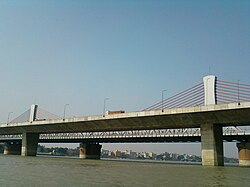Nivedita Setu is a multi-span extradosed bridge spanning the Hooghly River, connecting Bally, Howrah with Dakshineswar, Kolkata. It runs parallel to and about 50m downstream of the old Vivekananda Setu, opened in 1932. The bridge is named after Sister Nivedita, the social worker-disciple of Swami Vivekananda. The bridge is one of only five roadway bridges crossing the Hooghly River within the Kolkata metropolitan region. Belghoria Expressway which connects the meeting point of NH-16 with NH-19 at Dankuni to NH 12, Kalyani Expressway, Kolkata Airport and northern parts of Kolkata passes over the bridge. The bridge is designed to carry 48,000 vehicles per day.[1][2]
Nivedita Setu নিবেদিতা সেতু | |
|---|---|
 Nivedita Setu, with Vivekananda Setu behind, from the Hooghly River | |
| Coordinates | 22°39′08″N 88°21′12″E / 22.652286°N 88.353258°E |
| Carries | Belghoria Expressway, which is a part of NH-12, roadway only |
| Crosses | Hooghly River |
| Locale | Dakshineswar, Kolkata metropolitan region, |
| Named for | Sister Nivedita |
| Owner | National Highways Authority of India |
| Maintained by | Second Vivekananda Bridge Tollway Company Pvt. Ltd |
| Characteristics | |
| Design | Multi-span Extradosed bridge |
| Total length | 880 metres (2,890 ft) |
| Width | 29 metres (95 ft) |
| No. of spans | 7 |
| Piers in water | 6 |
| No. of lanes | 6 |
| History | |
| Architect |
|
| Constructed by | Larsen & Toubro |
| Construction start | April 2004 |
| Construction cost | 650 crore INR (equivalent to US$77.25 million) |
| Opened | July 2007 |
| Statistics | |
| Daily traffic | ~45,000 Vehicles |
| Toll | Yes, Tolled by SVBTC Ltd. |
| Location | |
 | |
Design
editThe 1932 Vivekananda Setu had become weak as a result of ageing and with heavy traffic even repairs became difficult. There was need for a second bridge.[2]
The main challenge was to design and construct a new bridge that did not mar the view of the old Vivekananda Setu, did not dwarf the historically important Dakshineswar Kali Temple which is located well within visible distance, and carry substantially higher levels of fast traffic for around half a century.[3]
The bridge rests on deep-well foundations going down to the river bed level. It carries six lanes for high speed traffic. The carriageway is supported by 254 pre-stressed concrete girders. Cables from 14m high pylons extend additional support.[3]
Nivedita Setu is the first bridge in the country that is a single profile cable-stayed bridge. By design, the height of the columns are lower than the tip of the Dakshineswar temple.[3]
Construction
editThis bridge is estimated to cost approximately Rs. 650 crore. The construction of the bridge started in April 2004, by the construction giant Larsen and Toubro and was opened to traffic in a record time in July 2007.[citation needed]
The bridge is the India's first multi-span, single-plane cable-supported extradosed bridge; with short pylons and seven continuous spans of 110 m, totaling a length of 880 m (2,887 feet). It is 29 m wide and supports 6 lanes of traffic.[2][3]
Award
editNivedita Setu has won an Award of Excellence from the American Segmental Bridge Institute, USA.[4]
Toll
edit| Category of Vehicles | Fee per vehicle per one way trip w.e.f. 04.07.2023 |
|---|---|
| Class-1 - Car, Passenger Van or Jeep | Rs 65 |
| Class-2 - Bus | Rs 125 |
| Class-3 - Light Good Vehicle (LGV) | Rs 175 |
| Class-4 - Truck | Rs 300 |
| Class-5 - Multi Axle vehicles (MAV), Earth Moving Equipment (EME) and Heavy Construction Machinery (HCM) including without limitation, oversized vehicles carrying boilers , turbines generators | Rs 350 |
See also
editReferences
edit- ^ "Second Ganga bridge running below capacity". Business Standard, 7 July 2008. Retrieved 6 July 2011.
- ^ a b c "Famous Bridges of India – Nivedita Setu". India Travel News. Archived from the original on 24 September 2015. Retrieved 6 July 2011.
- ^ a b c d "Second Vivekananda Bridge is a technological wonder". Tarak Banerjee. Retrieved 6 July 2011.
- ^ "Nivedita Setu bags award". The Hindu Business Line, 31 July 2008. Archived from the original on 22 September 2012. Retrieved 6 July 2011.